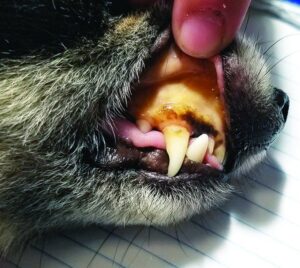
THE TIMING OF VACCINATIONS EXPLAINED
We have come to accept that vaccinations must be repeated annually but in light of new research, it may seem that our dogs are covered for longer than we think.
In 2016, the Vaccination Guidelines Group (VGG) of the World Small Animal Veterinary Association (WSAVA) published a set of guidelines with regard to dog and cat vaccinations. The document has been adapted by the South African Veterinary Association to align with our country’s circumstances. 1
The excerpts below can be found in both documents.
WSAVA/SAVA makes the distinction between core and non-core vaccines.
“Core vaccines protect animals from severe, life-threatening diseases that have global distribution.”
In dogs, these are rabies, distemper, adenovirus and parvovirus. In cats, they are panleukopenia, calicivirus, herpesvirus and rabies.
The VGG has defined non-core vaccines as “those that are required by only those animals whose geographical location, local environment or lifestyle places them at risk of contracting specific infections.” and that they “should be given no more frequently than is deemed necessary.”
“Non-core vaccines for dogs are for Leptospirosis, Bordetella bronchiseptica and Parainfluenza (PI). Besides the need to comply with some travel regulations, the need for the inclusion of Leptospira in routine vaccines may not be justified.
Non-core vaccines for cats are those against feline leukemia virus (FeLV), feline immunodeficiency virus (FIV), Chlamydophila felis, Bordetella bronchiseptica and feline infectious peritonitis (FIP) (Scherk et al. 2013)2.”
It needs to be recognised that non-core does not mean that they are non-essential as they may be of huge importance to the well-being of pets at risk.
INHERITED IMMUNITY
A mother’s first milk is called colostrum which contains antibodies. A puppy can only absorb them for about 4-6 hours after birth. So, the levels of antibodies received by a puppy or kitten after birth depend on the levels in the mother’s colostrum as well as who makes it first to suckle. Under natural conditions, the firstborn is generally the first to drink— the lastborn may only receive a small amount (sometimes called the runt because of it).
Most (not all) puppies and kittens are protected from infections thanks to something called MDA (maternally derived antibodies) in colostrum. This is called passive immunity and, in a healthy puppy, it can start waning from about 8-12 weeks old and interfere with man-made (or active) vaccines for up to 16 weeks. However, in some cases, the mother’s immunity is so poor that there is little to inherit at birth. On the other hand, puppies may have such a strong immunity that they are incapable of responding to active vaccinations until 12-16 weeks of age. In kittens, it is shown that they may start responding to active vaccines as early as 6 weeks old.
To overcome the complexity of individual circumstances in South Africa, the SAVA has made a ‘one-size-fits-all’ guideline regarding first core and non-core vaccinations. They state that puppies from 6-8 weeks old may be vaccinated with core vaccines, decreasing to 4 weeks of age in high-risk situations like shelters and breeding establishments. For kittens in high-risk environments, core vaccines can start as early as 4 weeks old.
The interval between initial vaccines is also said to be more effective at 3 weeks compared to the previously accepted 4-week period. In severe outbreak cases of parvovirus or upper respiratory diseases, the interval can be 2 weeks.
Since maternally derived antibodies can interfere with vaccinations for up to 16 weeks of age, the SAVA guidelines indicate that the last dose of a vaccine should be given when the puppy or kitten is at least this age. This means that even after the 6, 9 and 12-week course is complete, a fourth may be required at 16 weeks old. Alternatively, a titre test (a simple laboratory test that quantifies the level of antibodies in the blood against any given disease) can be performed to check immunity. If the puppy or kitten has only received the first 3 vaccinations up to 12 weeks of age, the SAVA guidelines state that it may be pertinent to give the 4th booster at the time of sterilistion (about 6 months old).
VACCINATING EVERY 3 YEARS
On the subject of re-vaccinating your pets every three years as opposed to annually, the SAVA guideline states,
“Vaccines should not be given needlessly. For low-risk pet dogs, the core vaccines should not be given any more frequently than every three years in dogs after the 6- or 12-month booster injection following the initial puppy or kitten series, because the duration of immunity is many years and may be up to the lifetime of the pet (Böhm et al. 2004)3. However, kennel regulations and travel regulations may require annual vaccination against core diseases even though they might not need them. Dogs at risk from non-core respiratory diseases (PI and Bordetella bronchiseptica) are those that show, travel and visit breeding or boarding kennels and should be vaccinated annually against these diseases.
In cats there is no evidence to support extended duration of immunity by allowing immunisation intervals longer than 12 months and to date there is no manufacturer’s datasheet supporting extended duration of immunity for either the FHV or FCV. Despite this, many vaccination guidelines encourage practitioners to only re-vaccinate every third year in cats in conflict with manufacturer’s label inserts, but stress that this should only be done in low-risk cat households and with owner consent (Day et al. 2016, Scherk et al. 2013)4.”
Concerning serological testing, the SAVA guidelines state that,
“Concerned practitioners and owners wishing to minimise unnecessary vaccinations in their patients and pets may use serological testing to confirm that the dog needs the three-year booster. This is because it has been shown that the immunity may last much longer than 3 years in some cases (Böhm et al. 2004)5. Testing and strategic vaccination may however be more expensive than routine vaccination.
Annual or strategic serologic testing has less application in cats as it is unlikely to expect protective titres for much longer than a year against FHV and FCV. Annual re-vaccination using core vaccines in this species can therefore be merited especially in cats at risk.”
WHEN TO START WORRYING
A clear understanding of viruses, bacteria and vaccines is important but how do we recognise when our pets are infected?
I have always maintained that pet owners know their pets better than anyone; mostly, you can tell when something is wrong with your furry friend. It is not in the scope of this article to offer a DIY diagnostic lesson to pet owners — this is the job of your vet or nurse — but there are a few indications of disease that can help us to make the right decisions for our pets in good time.
Many different symptoms indicate disease in your pet and many of them are the same for several different problems. Let us remain logical about symptoms before we make home diagnoses and try to treat our pets incorrectly.
Possibly the clearest indication that there is something wrong with your pet is inappetence. The unwillingness to eat plus a lethargic attitude indicates that an animal may feel nauseous or is in too much discomfort to eat. The intake of nutrition is what keeps our pets’ physiological systems healthy, so when this stops, it is important to seek medical attention. But, it is also important to look at this statement from your own experience with your pet. Is he or she a picky eater or are there stressful situations that can cause food avoidance?
Pale, yellow or dark pink mucous membranes are another warning sign that your pet may be ill. In fact, if your pet’s gums are a very different colour from what you are used to, it can indicate a problem. But remember that a cat’s gums may often look slightly paler than a dog’s and some pets have pigmented gums which make them look darker too. The point is to recognise what is normal for your pet. Go ahead and lift those top lips regularly to get a feeling for their normal colour. 
Vomiting and diarrhoea can lead to dehydration very quickly and are often an indication of infection and disease. But cats often vomit up food (especially dry diets) and dogs who have eaten too fast can also vomit. Again, it is important to consider your own pet’s habits. But unusual vomition and diarrhoea that persist after 24 hours must be flagged and seen by your veterinarian.
Your vet and vet nurse are trained to evaluate your pet’s basic physiological parameters in a consultation. Additionally, there are several rapid test kits available at your vet clinic that test for some of the more common viral and bacterial infections (like parvovirus, FiV and Felv). Results are available in minutes and the tests usually only require a few drops of blood or a small sample of faeces/urine. Microscopic evaluation of blood, faeces or urine can usually be done at your local vet too and are effective for parasitic diseases like Ehrlichia or Babesia. Most vet clinics are also able to send samples away to laboratories for further diagnostics.
To avoid the financial burden of hospitalisation, critical care, laboratory tests as well as the trauma that comes with seeing your pet suffering from avoidable infections, it is still the best policy to complete your pet’s vaccination schedule until he or she is covered. In this respect, prevention is by far more cost-effective and kinder than cure.
South Africa is truly a rainbow nation. From rich to poor and in-between, owning a pet is in our nature. But, with ownership comes responsibility and ever-increasing costs can make managing your pet’s health a little harder each month. We have never been able to eradicate any of the viruses mentioned above and it seems like an ongoing battle. But, with the correct timing of vaccines and more awareness about the viruses themselves, we may be on a path to success.
- DOG AND CAT VACCINATION GUIDELINES FOR SOUTH AFRICA (2019) – EVIDENCE, Compiled by Kurt de Cramer BVSc MMedVet (Gyn) PhD
- Scherk M. A.; Ford R. B.; Gaskell R. M.; Hartmann K.; Hurley K. F.; Lappin M. R.; Levy J. K.; Little S. E.; Nordone S. K.; Sparkes A. H., 2013: 2013 AAFP feline vaccination advisory panel report. Journal of feline medicine and surgery, 15785-808.
- Böhm M.; Herrtage M.; Thompson H.; Weir A.; Hasted A.; Maxwell N., 2004: Serum antibody titres to canine parvovirus, adenovirus and distemper virus in dogs in the UK which had not been vaccinated for at least three years. Veterinary Record, 154 457-463.
- Day M.; Horzinek M.; Schultz R.; Squires R., 2016: WSAVA Guidelines for the vaccination of dogs and cats. Journal of Small Animal Practice, 57E1-E45.
- Ibid
©Liz Roodt 2023
